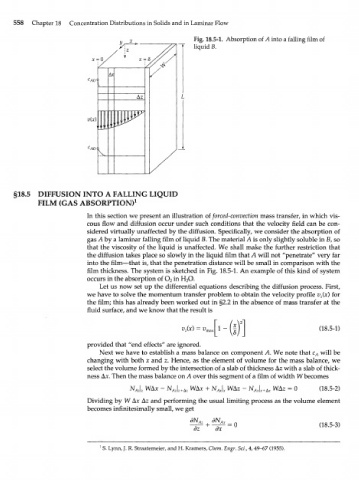Page 578 - Bird R.B. Transport phenomena
P. 578
558 Chapter 18 Concentration Distributions in Solids and in Laminar Flow
Fig. 18.5-1. Absorption of A into a falling film of
liquid B.
Ax
c A0
Az
ill w
v(x)
c A0
§18.5 DIFFUSION INTO A FALLING LIQUID
FILM (GAS ABSORPTION) 1
In this section we present an illustration of forced-convection mass transfer, in which vis-
cous flow and diffusion occur under such conditions that the velocity field can be con-
sidered virtually unaffected by the diffusion. Specifically, we consider the absorption of
gas Л by a laminar falling film of liquid B. The material A is only slightly soluble in B, so
that the viscosity of the liquid is unaffected. We shall make the further restriction that
the diffusion takes place so slowly in the liquid film that A will not "penetrate" very far
into the film—that is, that the penetration distance will be small in comparison with the
film thickness. The system is sketched in Fig. 18.5-1. An example of this kind of system
occurs in the absorption of O in H O.
2 2
Let us now set up the differential equations describing the diffusion process. First,
we have to solve the momentum transfer problem to obtain the velocity profile v (x) for
z
the film; this has already been worked out in §2.2 in the absence of mass transfer at the
fluid surface, and we know that the result is
v {x) = v (18.5-1)
z n
provided that "end effects" are ignored.
Next we have to establish a mass balance on component A. We note that c A will be
changing with both x and z. Hence, as the element of volume for the mass balance, we
select the volume formed by the intersection of a slab of thickness Az with a slab of thick-
ness Ax. Then the mass balance on A over this segment of a film of width W becomes
WAx - WAx + WAz - WAz = 0 (18.5-2)
N Az \ z N Az \ z+ b Z N Ax \ x N Ax \ x+Ax
Dividing by W Ax Az and performing the usual limiting process as the volume element
becomes innnitesimally small, we get
(18.5-3)
dz dx
1 S. Lynn, J. R. Straatemeier, and H. Kramers, Chem. Engr. Sci., 4,49-67 (1955).

